Trini Lopez: Little Mexico’s Greatest Export
by Paula Bosse
by Paula Bosse
Trini Lopez has sold millions of records. MILLIONS. He was born in Dallas in 1937 and grew up in the Little Mexico area of town. He started his career when he was a teenager at Crozier Tech High School, singing and playing guitar in a popular combo. He played at dozens of school dances and parties, and, with a steady and faithful following, he was much in demand at countless venues around town, including a regular 2:30-6:30 p.m. Sunday matinee spot at Club Vegas (Oak Lawn & Lemmon), one of the many clubs in the city run by Jack Ruby.
Jack Ruby — the personable Latin from Manhattan, reports surprising success with his Sunday night Fiestas at Club Vegas….
“There is a wide demand for Latin music in Dallas,” said the Oak Lawn impresario…. He is opening at 2:30 p.m. Sundays for matinee dances featuring Trini Lopez and his orchestra. The versatile Lopez combo offers an occasional Yanqui tune in addition to the likes of the “Jack Ruby Mambo.” (Tony Zoppi’s column in The Dallas Morning News, Dec. 19, 1956)
(I really want to hear that “Jack Ruby Mambo”!)
Speaking of the “Latin from Manhattan” (?!):
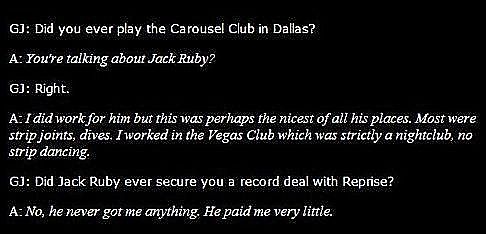 Ha! (From Gary James’ really great interview w/ Trini — see link at end.)
Ha! (From Gary James’ really great interview w/ Trini — see link at end.)
He also appeared on local TV, including Channel 8 shows hosted by a pre-Peppermint Jerry Haynes: “Jukebox” and “Top Ten Dancing Party.”
Trini’s first single was “The Right to Rock” — the first song he ever wrote — recorded in 1958 on a small Dallas label called Volk (did anyone else ever record for this label?).
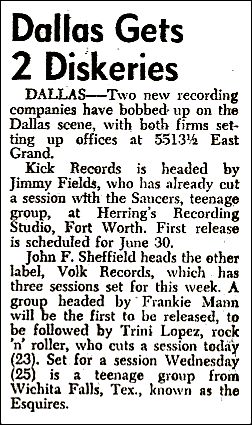 Billboard, June 23, 1958
Billboard, June 23, 1958
It’s a great little rockabilly number, but it didn’t really make any waves outside of Dallas (although it’s since found new life in the cult-y world of vintage rockabilly reissues).
∙
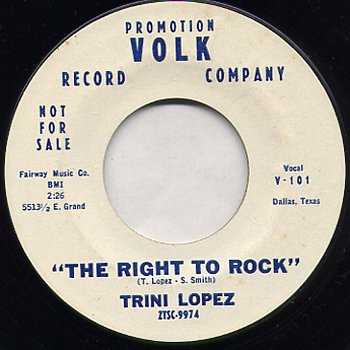
Trini then recorded a few singles for King, but those went nowhere as well, and Trini and his combo continued to play small clubs in and around DFW, wondering when the big break was going to come.
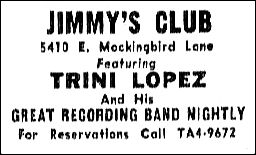 Jan., 1959
Jan., 1959
After a gig in Wichita Falls, Trini met fellow-Texan Buddy Holly who had been impressed by the young singer’s performance and encouraged him to contact his producer, Norman Petty, about recording some tracks at Petty’s studio in New Mexico. Trini jumped at the chance, but, unfortunately, the time in the studio at Clovis turned out to be a career low-point (see below for a link to the Gary James interview in which Trini gives a bitter and scathing account of that whole experience). Trini returned to Dallas and immediately fired his band and started a new one, determined that he would succeed, despite the prevailing (spoken and unspoken) racism he was continuing to run up against in the music business.
A few months after Buddy Holly’s death, the Crickets contacted Trini and asked him to travel to Los Angeles to discuss the possibility of becoming their new lead singer. Trini, seeing this as the big break he’d been waiting for, disbanded the combo and set out to the West Coast alone. The “audition” never really materialized, and Trini was stuck in California with no money and no prospects. He played a few small clubs and then settled into PJ’s for an extended and very successful engagement. It was there, in 1963, that the “big break” finally happened: he was discovered by producer Don Costa, who recommended that Frank Sinatra sign him to Reprise Records. Next thing you know, Trini had recorded his debut album, “Trini Lopez at PJ’s,” and the first single, “If I Had a Hammer,” was a huge smash hit, selling millions of copies and reaching #1 in 38 countries. Trini Lopez became an international star.
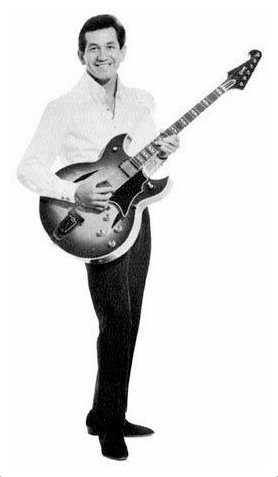
∙
At the beginning of 1964, he was booked for a series of shows in Paris where he shared the bill with The Beatles, just as they were about to hit big in the US (their Ed Sullivan appearance was less than a month away). Beatlemania was in full force in Europe, but Trini was also getting his share of attention.
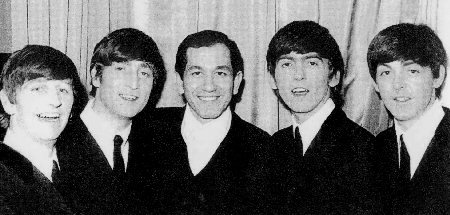
And, the rest, as they say, is history.
*
A couple of interesting things, Dallas-wise. My Trini Lopez knowledge is fairly scant, but having read a lot about him over the past couple of days, the one thing that keeps coming back when he talks about the Little Mexico section of town (invariably referred to by him as a “ghetto”) is how violent a place it was. He also recounts the deep and dehumanizing racial prejudice he and other Mexican-Americans experienced living in Dallas. When he left for Los Angeles in 1959/1960, he left for good. He came back regularly to visit his family (I remember having him pointed out to me by my parents in a restaurant once), but I’m not sure he would have ever wanted to live here again.
 From an interview by Robert Wilonsky (Dallas Observer, May 29, 2006)
From an interview by Robert Wilonsky (Dallas Observer, May 29, 2006)
*
Below are a few random interviews and tidbits.
Trini developed his own beat, a Tex-Mex style of rock and roll now popularly known as “the Trini beat” and which Trini describes as “American music with a Mexican feeing.” (DMN, July 12, 1964)
And from the same article:
“People in Dallas told me I had the talent but suggested I change my name. I said ‘No.’ I told them Italians had made it as Italians, Jews as Jews, and Negroes as Negroes. I wanted to make it as a Mexican. No one of Mexican-American heritage had made it before in the entertainment world. I wanted to be the first.” (DMN, July 12, 1964)
(According to Trini, the person who suggested he change he name was John F. Sheffield who owned Volk Records. Sheffield was okay with “Trini,” but he insisted the “Lopez” had to go. He suggested “Roper.” Trini refused and threatened to walk. Sheffield relented.)
 (Click for larger image – continues below.)
(Click for larger image – continues below.)
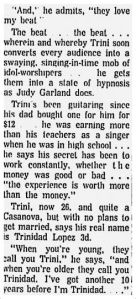 Earl Wilson’s syndicated column (July 1965)
Earl Wilson’s syndicated column (July 1965)
In 1969, Trini Lopez became a restaurateur and opened “Trini’s” at 5412 East Mockingbird, across from the old Dr Pepper plant (click for larger image):
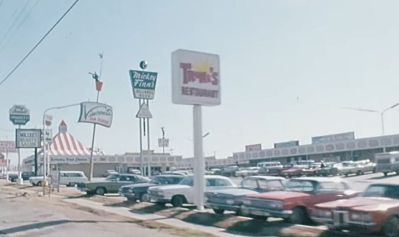 Screenshot, KERA, 1970 (Jones Film Collection, SMU)
Screenshot, KERA, 1970 (Jones Film Collection, SMU)
**
UPDATE: Sadly, Trini Lopez died on April 11, 2020 from complications of COVID-19. He was 83. Read his obituary in Variety here.
***
Sources & Notes
Full Dallas Observer interview by Robert Wilonsky is here.
There are a lot of garbled accounts of Trini Lopez’s career scattered across the internet. One that seems mostly right is here.
The essential interview with Trini by Gary James I’ve mentioned a couple of times above, is here. I think the interview is from 2002. His memories of growing up in Dallas are interesting, unvarnished, and well worth reading. He also talks about the racial prejudice he met with when attempting to record with Norman Petty and the resulting mutiny of his band in Clovis which led to their being fired by Trini immediately upon their return to Dallas.
Read Trini’s tribute to his parents — an essay he wrote in the early 1980s — here.
Trini Lopez’s official website is here.
Discovering Trini and his music has been surprisingly fun! Thanks, Trini! Check out this great, infectiously joyful performance of “La Bamba” with Jose Feliciano at a music festival in San Antonio in 1974. (Trini was performing “La Bamba” when he was still in Dallas, before Ritchie Valens had a hit with it — when Valens’ version hit the airwaves, Trini was crushed that someone had beaten him to recording it. He may not have recorded it first, but he had the bigger hit with it a few years later.)
*
Copyright © 2014 Paula Bosse. All Rights Reserved.


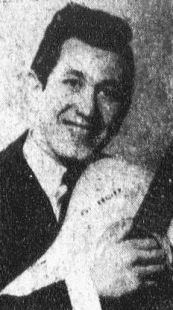

[…] “The Misters,” headed by the enormously popular Jesse Lopez (younger brother of Trini Lopez, who went to Crozier […]
LikeLike
Remember Trini’s Mexican Restaurant, in the strip center SE corner of Mockingbird and Homer/SW corner of Mockingbird and McMillan? It was a favorite of my family in the 60s and 70s.
Also, I ran across Trini Lopez in the mid 80s playing in the bar at Mariano’s (back when it was a nice bar, dark, cool with strong margaritas, before they turned it into a fern bar).
LikeLiked by 1 person
Yes, Mariano was a friend of his, a really classy guy. I use to make the background music tapes for him at KVIL until I programed the theme to JAWS on one of them. I didn’t get fired from the gig but sure got reprimanded!
LikeLiked by 2 people
Haha!
LikeLike
I booked Trini for summer semester sockhops at SMU in 1959 or 1960. And I was at l’Olympia in Paris when he was top of the bill, above the Beatles!
LikeLiked by 1 person
Wow! Lucky you!
LikeLike
[…] Bruce and Delbert weren’t the only DFW musicians with whom pre-Beatlemania Beatles hobnobbed: they also shared a bill in Paris with Dallas son Trini Lopez in 1963 — the Flashback Dallas post “Trini Lopez: Little Mexico’s Greatest Export” is here. […]
LikeLiked by 1 person
Trini, remember singing at some of the dances at North Dallas High with David and the Misters with your brother. I told my sister back then and asked her if it was true you were related. She said yes and something about you and lunch money -she is still waiting for her money. Her name is Mary Louise.
LikeLiked by 1 person
[…] Nominees are: Mark Carroll, Marty Ross, Earl Humphreys (the previous year’s winner), Skip Fletcher, Charlie Applewhite, Ron Shipman, and Trini Lopez. […]
LikeLike
I worked at Trini’s, from before it opened, in early March, 1969. The manager, Mr. Lane was cleaning the place and setting up decorative crates above the booths along the walls.
Trini was there for the opening gala, and came by a few times after that. He always seemed cheery, had a bounce to his step.
I worked there after school until I graduated in 1972. Around that time, it was bought and run by El Chico.
LikeLiked by 1 person
Thanks for the additional info, Robert!
LikeLike
Paula- I looked through your blog and read a few entries, I remember the Aldredge Bookstore house on McKinney Ave. because we lived on Boll St. one short block from McKinney.
We lived there in the mid-sixties. I also remember the second location, there was a Shell or Enco gas station near there, right?
The station was on Cedar Springs.
And, I also remember the building on Maple Ave. I worked a couple of blocks from there, at Oak Lawn and Maple from 1980 until my retirement in 2015.
I feel fortunate to have lived in that area of the city during that time, and I’m sure you feel the same way about you and your time there.
LikeLiked by 1 person
Yes, Robert! Those were the three locations of the store. That part of town — pre “Uptown” — was such a cool, old, funky, diverse neighborhood. It’s completely (and I meant COMPLETELY) unrecognizable these days. Thanks for commenting!
LikeLike